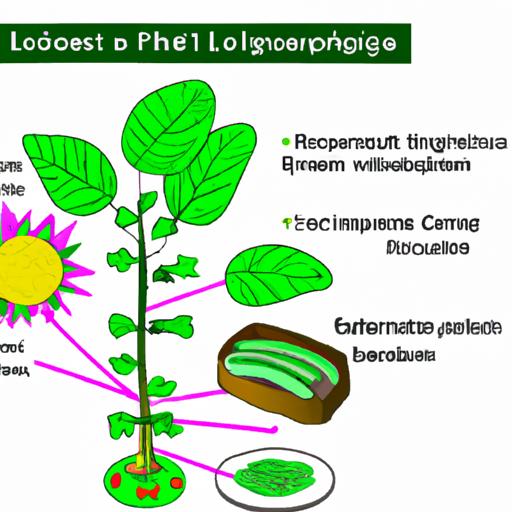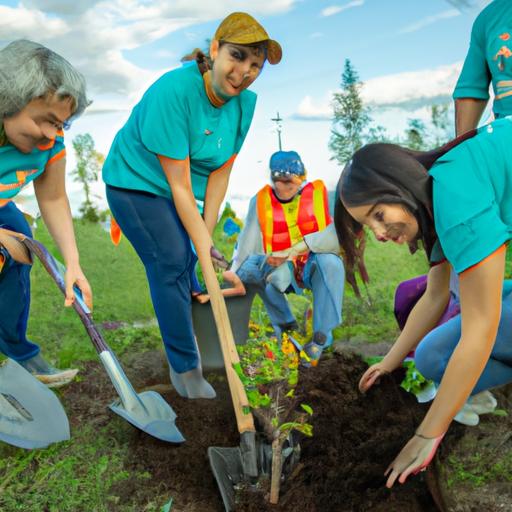Introduction
Planting trees is not just an act of nurturing nature; it is a testament to our commitment to preserving the beauty and vitality of our planet. As we witness the alarming consequences of deforestation and climate change, the significance of tree planting becomes ever more apparent. Each sapling holds the potential to combat environmental degradation, enhance biodiversity, and mitigate the effects of climate change. But who truly holds the power to plant these trees and initiate positive change?
In this article, we unravel the pivotal role individuals play in tree planting efforts. By exploring the importance of tree planting and the collective actions we can take, we discover the immense impact each one of us can have on our environment. So, let’s delve into the world of tree planting and unveil the power of individuals in environmental conservation.
A. Importance of Tree Planting
Imagine a world devoid of lush green forests, where the symphony of rustling leaves and chirping birds is silenced. Trees are not mere silent spectators; they are the lungs of our planet, absorbing carbon dioxide and releasing life-giving oxygen. By planting trees, we restore balance to a fragile ecosystem, combatting deforestation, and promoting sustainable development.
But the significance of tree planting extends far beyond environmental conservation. Trees provide habitat for countless species, safeguard watersheds, prevent soil erosion, and even enhance air quality in urban areas. Moreover, they serve as natural cooling systems, reducing the impact of heatwaves and combating the urban heat island effect. The benefits are manifold, making tree planting a crucial part of our responsibility towards future generations.
B. Role of Individuals in Tree Planting
Now, you might be wondering, “How can I, as an individual, make a meaningful impact through tree planting?” The answer lies in the power of collective action. Every sapling you plant contributes to a greener and healthier world. By taking personal responsibility and actively participating in tree planting initiatives, you become a catalyst for change.
Indeed, your involvement in tree planting can inspire others to follow suit. Whether you plant a tree in your backyard, join community-led projects, or support environmental organizations, your efforts ripple outward, fostering a culture of environmental consciousness. Together, we can create a movement that transcends boundaries, cultivating a sustainable future for generations to come.
In the upcoming sections, we will explore the various avenues through which individuals can engage in tree planting. From choosing the right tree species to identifying suitable planting locations, we will equip you with the knowledge and resources needed to embark on your own tree planting journey. So, join me in discovering how each one of us can contribute to the noble cause of tree planting and become stewards of our planet’s well-being.
The Definition and Concept of Tree Planting
A. Understanding the Significance of Tree Planting
Tree planting goes beyond merely putting seeds or saplings into the ground. It embodies a profound commitment to the well-being of our planet and future generations. By understanding the significance of tree planting, we can fully appreciate the impact it has on our environment.
The Power of Reforestation
Deforestation has ravaged our forests, leaving barren landscapes in its wake. However, tree planting acts as a powerful solution to reverse this damage. Through reforestation efforts, we can restore ecosystems, promote biodiversity, and create sustainable habitats for countless species. Each tree planted holds the potential to combat climate change, as they absorb carbon dioxide and release oxygen, acting as natural carbon sinks.
Promoting Sustainable Development
Tree planting is an integral part of sustainable development. By planting trees, we protect watersheds, prevent soil erosion, and improve water quality. Forests also play a crucial role in regulating local and regional climates, mitigating the impact of natural disasters such as floods and landslides. Moreover, trees provide valuable resources such as timber, fruits, and medicinal plants, contributing to the economic well-being of communities.
B. Environmental Benefits of Tree Planting
The environmental benefits of tree planting are vast and far-reaching. Let’s explore some of the ways in which trees positively impact our natural surroundings.
Mitigating Climate Change
Trees act as natural climate regulators, helping to counteract the effects of global warming. Through photosynthesis, trees absorb carbon dioxide, a major greenhouse gas, and store it in their trunks, branches, and leaves. This process helps to reduce the concentration of carbon dioxide in the atmosphere, mitigating the greenhouse effect and slowing down climate change.
Enhancing Biodiversity and Ecosystems
Forests are home to a rich tapestry of plant and animal species, forming complex ecosystems. By planting trees, we create habitats for wildlife, allowing them to thrive and maintain the delicate balance of biodiversity. Additionally, trees provide food, shelter, and nesting sites for numerous species, contributing to the overall health and resilience of ecosystems.
Improving Air and Water Quality
Trees play a crucial role in improving air quality by filtering out pollutants and releasing oxygen. They act as natural air purifiers, reducing the levels of harmful gases and particulate matter in the atmosphere. Similarly, trees help to maintain the quality of our water resources by intercepting rainfall, reducing runoff, and filtering water before it reaches rivers and streams.
As we delve further into the realm of tree planting, we will explore the different individuals and organizations involved in these efforts. Join me in the next section as we uncover the inspiring stories and initiatives that are transforming landscapes and shaping a greener future.
Who Plants Trees?
A. Individuals as Tree Planters
1. Motivations behind Tree Planting
What drives individuals to take up the noble task of tree planting? The motivations are as diverse as the people themselves. Some plant trees to create a greener and more beautiful environment for their communities. Others are motivated by a deep sense of responsibility towards future generations, understanding that trees are essential for a sustainable future. Additionally, many individuals find solace and fulfillment in connecting with nature and contributing to its preservation.
2. Benefits of Personal Involvement in Tree Planting
Engaging in tree planting not only benefits the environment but also offers personal rewards. As you plant and care for trees, you forge a profound connection with nature, experiencing a sense of purpose and fulfillment. Witnessing the growth and flourishing of the trees you planted brings a unique joy and a tangible reminder of the positive impact you are making.
Moreover, tree planting provides an opportunity for learning and personal growth. It allows you to deepen your understanding of ecosystems, improve your gardening skills, and develop a greater appreciation for the intricate web of life. By immersing yourself in the process, you become an active participant in environmental conservation, leaving a lasting legacy for future generations.
B. Organizations and NGOs Involved in Tree Planting
1. Notable Organizations Promoting Tree Planting
In addition to individual efforts, numerous organizations and non-governmental organizations (NGOs) are playing a crucial role in tree planting initiatives. These organizations are dedicated to preserving and restoring forests, combating deforestation, and raising awareness about the importance of trees. Notable organizations such as the Arbor Day Foundation, One Tree Planted, and Trees for the Future have made significant strides in promoting tree planting on a global scale.
2. Collaboration Opportunities with Organizations
Collaborating with organizations involved in tree planting can amplify your impact and provide valuable resources and support. Many of these organizations offer volunteer programs, allowing you to actively contribute to tree planting projects in local communities or even in distant lands. By joining forces with like-minded individuals and organizations, you can leverage collective expertise and resources to make a more significant and lasting difference.
Furthermore, partnerships with organizations offer opportunities for education and advocacy. You can participate in workshops, seminars, and awareness campaigns to deepen your knowledge and inspire others to join the cause. Through collaboration, we foster a sense of collective responsibility and create a network of passionate individuals working towards a common goal.
In the upcoming sections, we will explore how individuals can get involved in tree planting, from identifying suitable locations to choosing the right tree species. Together, we will unlock the power of individuals as tree planters and delve deeper into the impact of our collective efforts. Let’s continue our journey towards a greener and more sustainable future.
How Individuals Can Get Involved in Tree Planting
A. Identifying Suitable Locations for Tree Planting
When it comes to planting trees, location plays a crucial role in determining the success and impact of your efforts. Start by identifying areas that would benefit from tree planting, such as parks, school grounds, or community spaces. Consider the specific needs of your chosen location, such as soil conditions, sunlight exposure, and available space. Engage with local authorities or environmental organizations to gain insight into potential planting sites and obtain necessary permissions.
B. Choosing the Right Tree Species
Selecting the appropriate tree species is vital to ensure the long-term survival and ecological value of your plantings. Research native tree species that are well-adapted to your local climate and soil conditions. Native trees are more resilient, requiring less maintenance and providing essential habitat for local wildlife. Consult local nurseries, forestry departments, or online resources to gather information about suitable tree species. Aim for diversity in your selection, considering factors like tree size, growth rate, and environmental benefits.
C. Techniques for Successful Tree Planting
Planting a tree is not as simple as digging a hole and placing the sapling. Follow these techniques to ensure successful establishment and growth:
-
Preparation: Dig a hole that is wide and deep enough to accommodate the roots, ensuring good soil contact.
-
Root Care: Gently loosen the roots of the sapling before planting, ensuring they are not tightly wound.
-
Planting Depth: Place the sapling in the hole, ensuring that the root flare is level with or slightly above the ground surface.
-
Backfilling: Fill the hole with soil, gently firming it around the roots to eliminate air pockets.
-
Watering: Provide ample water after planting, ensuring the soil is moist but not waterlogged. Continue regular watering during the establishment phase.
-
Mulching: Apply a layer of organic mulch around the base of the tree, keeping it away from the trunk. Mulch helps retain moisture, suppress weeds, and regulate soil temperature.
D. Maintenance and Care of Planted Trees
Once your trees are planted, they require ongoing care and maintenance to thrive. Regularly monitor the moisture levels in the soil and water as needed, especially during dry periods. Prune any dead or damaged branches to promote healthy growth. Apply organic fertilizers sparingly, if necessary, and avoid using harmful pesticides or herbicides. Stay vigilant against pests and diseases, promptly addressing any issues that arise. Regularly assess the overall health and growth of your trees, seeking professional advice if needed.
By following these practices, you can ensure the long-term success of your tree planting endeavors and contribute to the flourishing natural environment. Remember, your commitment to maintenance and care is crucial in nurturing the trees and maximizing their positive impact on the ecosystem. Let’s continue our journey towards becoming dedicated stewards of our planted trees and champions of environmental sustainability.
Impact of Tree Planting Efforts
Tree planting goes beyond the act of putting saplings into the ground; it holds the potential to transform our environment, society, and economy. Let’s explore the profound impact of tree planting efforts across different aspects of our lives.
A. Environmental Benefits
When we plant trees, we become guardians of our environment, nurturing a sustainable ecosystem. The environmental benefits of tree planting are vast and far-reaching. Trees act as natural filters, absorbing pollutants and improving air quality. They reduce noise pollution, provide shade, and create microclimates that support diverse flora and fauna.
Furthermore, trees play a crucial role in conserving water. Their roots help prevent soil erosion and regulate water cycles, reducing the risk of floods and ensuring a steady supply of clean water. Additionally, forests act as carbon sinks, absorbing harmful greenhouse gases and mitigating the impacts of climate change.
B. Social and Economic Impact
Tree planting initiatives have a profound impact on society and the economy. The presence of trees in urban areas enhances the aesthetics of neighborhoods, creating a sense of tranquility and well-being. Green spaces with trees promote physical and mental health, offering opportunities for recreation, relaxation, and stress reduction. Studies have shown that access to green spaces can even improve academic performance and boost community cohesion.
From an economic perspective, tree planting initiatives generate employment opportunities, supporting local communities. Nurseries, tree care services, and eco-tourism ventures flourish as trees become integral components of sustainable development. Moreover, the increased property values associated with green spaces and well-maintained urban forests contribute to economic growth.
C. Climate Change Mitigation
As our planet faces the challenges of climate change, tree planting emerges as a powerful tool for mitigation. Trees absorb carbon dioxide, one of the primary greenhouse gases responsible for global warming. By sequestering carbon, trees combat climate change, helping to stabilize temperatures and reduce the impact of extreme weather events.
Additionally, trees contribute to the water cycle, regulating rainfall patterns and reducing the risks of drought and floods. As climate change intensifies, the resilience of our ecosystems becomes increasingly crucial. With their ability to adapt and provide natural buffers, trees play a vital role in building climate resilience and ensuring the well-being of both human and natural communities.
In conclusion, the impact of tree planting efforts is multi-faceted, encompassing environmental, social, and economic dimensions. By planting trees, we forge a path towards a greener, healthier future. The benefits ripple through our communities, fostering a sense of collective responsibility and inspiring others to join the cause. So, let’s continue to nurture and celebrate the power of tree planting, knowing that each sapling we plant contributes to a brighter, more sustainable world.




